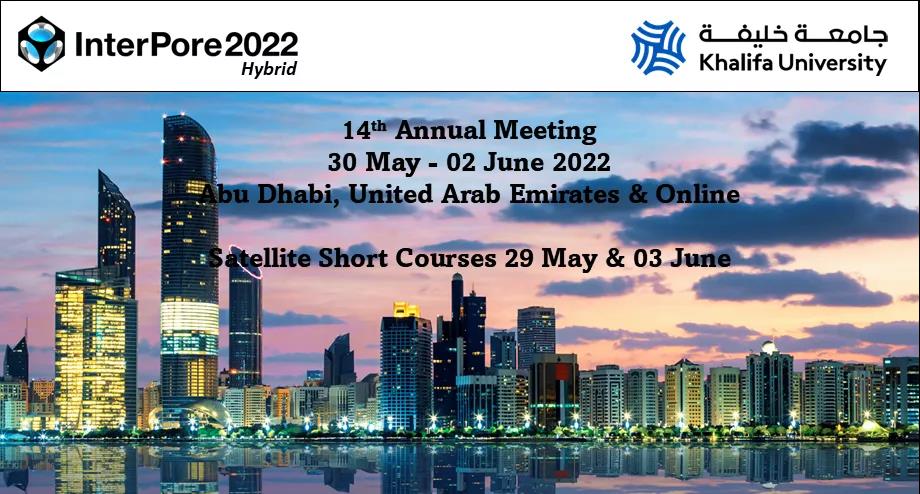Experimental investigation of CO2 residual trapping in naturally water-wet and artificially tailored oil-wet limestones: Implications for geological CO2 storage
Abstract view|368|times PDF download|230|times Supplements download|78|times
Abstract
Abstract:
The wetting behavior of rock/CO2/brine systems highly impacts the fluid distribution at the pore-scale and multiphase flow at the macroscale and is considered a key parameter controlling the CO2 residual trapping in geological storage. The effect of wettability on residual trapping is, however, still uncertain as the current literature suggests high discrepancies among the published datasets. Moreover, the dataset for residual trapping observations for non water-wet carbonate rocks is relatively scarce; none of the published studies investigated this aspect in CO2-wet limestones. Thus, a series of core-flooding experiments was conducted at reservoir conditions for three limestone samples having different wettability states, water-wet, intermediate wet, and CO2-wet. Wettability alteration of sister rocks was achieved using stearic acid to mimic the wettability alteration in saline aquifers due to the interaction with natural organic compounds. Notably, increasing the hydrophobicity of limestone tends to decrease CO2 residual trapping efficiency ∼ 19% and 37% when the initial water-wetting state shifts to intermediate-wet and CO2-wet, respectively. This is attributed to the fluid distribution at the pore scale, in particular the wetting layers, and its effect on the CO2/brine displacement. In case of CO2-wet rocks, macroscopic CO2 wetting layers act as flow paths, which reduces the residual CO2 saturation from 29% (water-wet) to 8%. These findings advocate water-wet rocks as better candidates for CO2 residual trapping and provide insights into residual trapping-rock wettability correlation pertinent to CO2 geo-storage.
Document Type: Original article
Cited as: Mouallem, J., Al-Abdrabalnabi, R., Raza, A., Mahmoud, M., Isah, A., Arif, M. Experimental investigation of CO2 residual trapping in naturally water-wet and artificially tailored oil-wet limestones: Implications for geological CO2 storage. Advances in Geo-Energy Research, 2025, 17(1): 43-55. https://doi.org/10.46690/ager.2025.07.04
Keywords
References
AlDhuhoori, M., Belhaj, H., AlHameli, F., et al. Assessment of mineral compositions on geo-mechanical time dependent plastic creep deformation. International Journal of Hydrogen Energy. 2024, 83: 472-490.
Ali, F., Negash, B., Ridha, S., et al. A review on the interfacial properties of caprock/CO2/brine system-implications for structural integrity of deep saline aquifers during geological carbon storage. Earth-Science Reviews, 2023, 246: 104600.
Ali, M., Awan, F. U. R., Ali, M., et al. Effect of humic acid on CO2-wettability in sandstone formation. Journal of Colloid Interface Science, 2021, 588: 315-325.
Ali, M., Pan, B., Yekeen, N., et al. Assessment of wettability and rock-fluid interfacial tension of caprock: Implications for hydrogen and carbon dioxide geo-storage. International Journal of Hydrogen Energy, 2022, 47(30): 1410414120.
Al-Khdheeawi, E. A., Vialle, S., Barifcani, A., et al. Impact of reservoir wettability and heterogeneity on CO2 -plume migration and trapping capacity. International Journal of Greenhouse Gas Control, 2017, 58: 142-158.
Al-Menhali, A. S., Krevor, S. Capillary Trapping of CO2 in Oil Reservoirs: Observations in a Mixed-Wet Carbonate Rock. Environmental Science and Technology, 2016, 50(5): 2727-2734.
Al-Shirawi, M., Karimi, M., Al-Maamari, R. S. Impact of carbonate surface mineralogy on wettability alteration using stearic acid. Journal of Petroleum Science and Engineering, 2021, 203: 108674.
Andrew, M., Bijeljic, B., Blunt, M. J. Pore-scale contact angle measurements at reservoir conditions using X-ray microtomography. Advances in Water Resources, 2014, 68: 24-31.
Arain, Z. U. A., Aftab, A., Ali, M., et al. Influence of stearic acid and alumina nanofluid on CO2 wettability of calcite substrates: Implications for CO2 geological storage in carbonate reservoirs. Journal of Colloid and Interface Science, 2023, 646: 567-575.
Baban, A., Ali, M., Arif, M., et al. Effect of organic acids on CO2 trapping in carbonate geological formations: Porescale observations using NMR. Energy & Fuels, 2023a, 37(4): 2983-2992.
Baban, A., Al-Yaseri, A., Keshavarz, A., et al. CO2-brinesandstone wettability evaluation at reservoir conditions via Nuclear Magnetic Resonance measurements. International Journal of Greenhouse Gas Control, 2021, 111: 103435.
Baban, A., Keshavarz, A., Amin, R., et al. Impact of wettability alteration on CO2 residual trapping in oil-wet sandstone at reservoir conditions using nuclear magnetic resonance. Energy & Fuels, 2022, 36(22): 13722-13731.
Baban, A., Keshavarz, A., Amin, R., et al. Residual trapping of CO2 and enhanced oil recovery in oil-wet sandstone core - A three-phase pore-scale analysis using NMR. Fuel. 2023b, 332(1): 126000.
Bachu, S. Drainage and imbibition CO2/brine relative permeability curves at in situ conditions for sandstone formations in western Canada. Energy Procedia, 2013, 37: 4428-4436.
Burnside, N. M, Naylor, M. Review and implications of relative permeability of CO2/brine systems and residual trapping of CO2. International Journal of Greenhouse Gas Control, 2014, 23: 1-11.
Chaudhary, K., Bayani Cardenas, M., Wolfe, W. W., et al. Pore-scale trapping of supercritical CO2 and the role of grain wettability and shape. Geophysical Research Letters, 2013, 40(15): 3878-3882.
Gao, X., Yang, S., Wang, B. et al. Pore-scale modeling of multiple fluids flow transport kinetics for CO2 enhanced gas recovery. Energy, 2025, 315: 134486.
Hu, R., Wan, J., Kim, Y., et al. Wettability impact on supercritical CO2 capillary trapping: Pore-scale visualization and quantification. Water Resources Research, 2017, 53(8): 6377-6394.
Iglauer, S. CO2-water-rock wettability: Variability, influencing factors, and implications for CO2 geostorage. Accounts of Chemical Research, 2017, 50(5): 1134-1142.
Iglauer, S., Paluszny, A., Rahman, T., et al. Residual trapping of CO2 in an oil-filled, oil-wet sandstone core: Results of three-phase pore-scale imaging. Geophysical Research Letters, 2019, 46(20): 11146-11154.
Iglauer, S., Salamah, A., Sarmadivaleh, M., et al. Contamination of silica surfaces: Impact on water-CO2-quartz and glass contact angle measurements. International Journal of Greenhouse Gas Control, 2014, 22: 325-328.
Isah, A., Mahmoud, M., Arif, M., et al. Influence of surface cleaning on the wettability of calcite/oil/brine systems. Fuel, 2023, 351: 128908.
Juanes, R., Spiteri, E. J., Orr, F. M., et al. Impact of relative permeability hysteresis on geological CO2 storage. Water Resources Research, 2006, 42(12): W12418.
Krevor, S., Blunt, M. J., Benson, S. M., et al. Capillary trapping for geologic carbon dioxide storage - From pore scale physics to field scale implications. International Journal of Greenhouse Gas Control, 2015, 40: 221-237.
Krevor, S., de Coninck, H., Gasda, S. E., et al. Subsurface carbon dioxide and hydrogen storage for a sustainable energy future. Nature Reviews Earth and Environment, 2023, 4(2): 102-118.
Land, C.S. Calculation of imbibition relative permeability for two- and three-phase flow from rock properties. Society of Petroleum Engineers Journal, 1968, 8(2): 149-156.
Lawal, U., Khan, H. J., Alajmei, S., et al. Evaluating CO2 residuals in water aquifers and depleted oil reservoirs via X-ray core-flooding experiments. Energy & Fuels, 2024, 38(18): 17761-17769.
Lundegard, P. D., Kharaka, Y.K. Distribution and occurrence of organic acids in subsurface waters, in Organic Acids in Geological Processes. Springer Berlin Heidelberg, Berlin, Heidelberg, pp. 40-69, 1994.
Mirzaei-Paiaman, A., Okuno, R. Critical review on wettability, optimal wettability, and artificial wettability alteration in rock-brine-CO2 systems for geologic carbon sequestration. Gas Science and Engineering, 2024, 132: 205499.
Mouallem, J., Arif, M., Isah, A., et al. Effect of formation brine on interfacial interaction: Implications for CO2 storage. Fuel, 2024, 371(B): 131986.
Mouallem, J., Raza, A., Glatz, G., et al. Estimation of CO2brine interfacial tension using machine learning: Implications for CO2 geo-storage. Journal of Molecular Liquids, 2023, 393: 123672.
Mouallem, J., Raza, A., Mahmoud, M., et al. Impact of petrophysical properties on CO2 residual trapping in limestone formations. Fuel, 2025, 396: 135327.
Mutailipu, M., Liu, Y., Jiang, L., et al. Measurement and estimation of CO2–brine interfacial tension and rock wettability under CO2 sub- and super-critical conditions. Journal of Colloid and Interface Science, 2019, 534: 605617.
Purswani, P., Johns, R. T., Karpyn, Z. T. Impact of wettability on capillary phase trapping using pore-network modeling. Advances in Water Resources, 2024, 184: 104606.
Rahman, T., Lebedev, M., Barifcani, A., et al. Residual trapping of supercritical CO2 in oil-wet sandstone. Journal of Colloid and Interface Science, 2016, 469: 63-68.
Rasmusson, K., Rasmusson, M., Tsang, Y., et al. Residual trapping of carbon dioxide during geological storageInsight gained through a pore-network modeling approach. International Journal of Greenhouse Gas Control, 2018, 74: 62-78.
Rezk, G. M., Adebayo, A. R., Al-Yaseri, A., et al. Understanding gas capillary entrapment in sandstone and carbonate aquifer rocks: Impact of gas type and pore structure. Fuel, 2024, 374: 132414.
Spiteri, E. J., Juanes, R., Blunt, M. J., et al. A new model of trapping and relative permeability hysteresis for all wettability characteristics. SPE Journal, 2008, 13(3): 277288.
Spurin, C., Callas, C., Darraj, N., et al. The importance and challenges associated with multi-scale heterogeneity for geological storage. InterPore Journal, 2025, 2(1): IPJ260225-2.
Stevar, M., Bohm, C., Notarki, K., et al. Wettability of calcite under carbon storage conditions. International Journal of Greenhouse Gas Control, 2019, 84: 180-189.
Teng, Y., Wang, P., Xie, H., et al. Capillary trapping characteristics of CO2 sequestration in fractured carbonate rock and sandstone using MRI. Journal of Natural Gas Science and Engineering, 2022, 108: 104809.
Wang, Y., Wang, J., Liu, H., et al. Effects of acid–rock reaction on physical properties during CO2-rich industrial waste gas (CO2-rich IWG) injection in shale reservoirs. Petroleum Science, 2024, 21(1): 272-285.
Wei, B., Wang, B., Li, X., et al. CO2 storage in depleted oil and gas reservoirs: A review. Advances in Geo-Energy Research, 2023, 9(2): 76-93.
DOI: https://doi.org/10.46690/ager.2025.07.04
Refbacks
- There are currently no refbacks.
Copyright (c) 2025 The Author(s)

This work is licensed under a Creative Commons Attribution-NonCommercial-NoDerivatives 4.0 International License.


